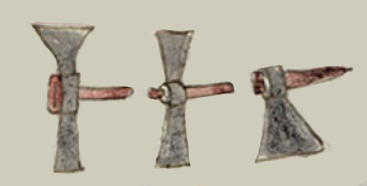tepoztli (CST28)
This painting of the simplex glyph for the term tepoztli (here, iron) shows three examples of iron axes or hatchets with wooden handles. The blades are varying shapes and sizes. The way they are attached to the wood, in all cases, involves embedding the wood into a hole in the piece of iron. The shape of the hole in the piece of iron varies from round, or square, to rectangular. In all cases, the metal is painted a dark gray color, and the wood is reddish.
Stephanie Wood
For more on the Codex Sierra, see Kevin Terraciano’s study (2021), especially pp. 118 and 152 for the transcription and translation of the relevant passages describing these tools. Below are other glyphs for the term tepoztli, which often refers to copper and also typically refers to axes or hatchets (but not exclusively). The metal piece of an ax or hatchet in the Codex Mendoza–almost two decades earlier than this manuscript–is typically tied on with what may be a leather strip.
Stephanie Wood
1550–1564
Jeff Haskett-Wood
metales, hierro, herramientas, hachas

tepoz(tli), copper, metal, iron, axes or hatchets, https://nahuatl.wired-humanities.org/content/tepoztli
hachas de hierro
Stephanie Wood
Códice Sierra-Texupan, plate 28, page dated 1559. Origin: Santa Catalina Texupan, Mixteca Alta, State of Oaxaca. Kevin Terraciano has published an outstanding study of this manuscript (Codex Sierra, 2021), and in his book he refers to alphabetic and “pictorial” writing, not hieroglyphic writing. We are still counting some of the imagery from this source as hieroglyphic writing, but we are also including examples of “iconography” where the images verge on European style illustrations or scenes showing activities. We have this iconography category so that such images can be fruitfully compared with hieroglyphs. Hieroglyphic writing was evolving as a result of the influence of European illustrations, and even alphabetic writing impacted it.
https://bidilaf.buap.mx/objeto.xql?id=48281&busqueda=Texupan&action=search
The Biblioteca Digital Lafragua of the Biblioteca Histórica José María Lafragua in Puebla, Mexico, publishes this Códice Sierra-Texupan, 1550–1564 (62pp., 30.7 x 21.8 cm.), referring to it as being in the “Public Domain.” This image is published here under a Creative Commons license, asking that you cite the Biblioteca Digital Lafragua and this Visual Lexicon of Aztec Hieroglyphs.







